Inter-Individual Variability in Motor Output Is Driven by Recruitment Gain in the Corticospinal Tract Rather Than Motor Threshold
Abstract
1. Introduction
2. Materials and Methods
2.1. Participants
2.2. Input–Output Curve (IOC)
2.3. Predicting MEP Amplitude
2.4. Variability in MEP Amplitude
3. Results
3.1. Correlation Analysis
3.2. General Linear Model (GLM) for Predicting MEP Amplitude
3.3. Strength of the Predictive Model
3.4. Analysing the Variability of Parameters
4. Discussion
5. Conclusions
Supplementary Materials
Author Contributions
Funding
Institutional Review Board Statement
Informed Consent Statement
Conflicts of Interest
References
- Eldaief, M.C.; Press, D.Z.; Pascual-Leone, A. Transcranial Magnetic Stimulation in Neurology A Review of Established and Prospective Applications. Neurol. Clin. Pract. 2013, 3, 519–526. [Google Scholar] [CrossRef] [PubMed]
- Di Lazzaro, V.; Oliviero, A.; Pilato, F.; Saturno, E.; Dileone, M.; Mazzone, P.; Insola, A.; Tonali, P.A.; Rothwell, J.C. The Physiological Basis of Transcranial Motor Cortex Stimulation in Conscious Humans. Clin. Neurophysiol. 2004, 115, 255–266. [Google Scholar] [CrossRef]
- Rawji, V.; Latorre, A.; Sharma, N.; Rothwell, J.C.; Rocchi, L. On the Use of TMS to Investigate the Pathophysiology of Neurodegenerative Diseases. Front. Neurol. 2020, 11, 584664. [Google Scholar] [CrossRef] [PubMed]
- Di Lazzaro, V.; Ziemann, U. The Contribution of Transcranial Magnetic Stimulation in the Functional Evaluation of Microcircuits in Human Motor Cortex. Front. Neural Circuits 2013, 7, 18. [Google Scholar] [CrossRef] [PubMed]
- Chen, R.; Tam, A.; Bütefisch, C.; Corwell, B.; Ziemann, U.; Rothwell, J.C.; Cohen, L.G. Intracortical Inhibition and Facilitation in Different Representations of the Human Motor Cortex. J. Neurophysiol. 1998, 80, 2870–2881. [Google Scholar] [CrossRef]
- Duclay, J.; Pasquet, B.; Martin, A.; Duchateau, J. Specific Modulation of Corticospinal and Spinal Excitabilities during Maximal Voluntary Isometric, Shortening and Lengthening Contractions in Synergist Muscles. J. Physiol. 2011, 589, 2901–2916. [Google Scholar] [CrossRef]
- Houdayer, E.; Degardin, A.; Cassim, F.; Bocquillon, P.; Derambure, P.; Devanne, H. The Effects of Low- and High-Frequency Repetitive TMS on the Input/Output Properties of the Human Corticospinal Pathway. Exp. Brain Res. 2008, 187, 207–217. [Google Scholar] [CrossRef]
- Thomas, S.L.; Gorassini, M.A. Increases in Corticospinal Tract Function by Treadmill Training after Incomplete Spinal Cord Injury. J. Neurophysiol. 2005, 94, 2844–2855. [Google Scholar] [CrossRef]
- Devanne, H.; Lavoie, B.A.; Capaday, C. Input-Output Properties and Gain Changes in the Human Corticospinal Pathway. Exp. Brain Res. 1997, 114, 329–338. [Google Scholar] [CrossRef]
- Carroll, T.J.; Riek, S.; Carson, R.G. Reliability of the Input-Output Properties of the Cortico-Spinal Pathway Obtained from Transcranial Magnetic and Electrical Stimulation. J. Neurosci. Methods 2001, 112, 193–202. [Google Scholar] [CrossRef]
- Capaday, C. Neurophysiological Methods for Studies of the Motor System in Freely Moving Human Subjects. J. Neurosci. Methods 1997, 74, 201–218. [Google Scholar] [CrossRef]
- Massie, C.L.; Malcolm, M.P. Considerations for Stimulus-Response Curves in Stroke: An Investigation Comparing Collection and Analysis Methods. Int. J. Neurosci. 2013, 123, 175–183. [Google Scholar] [CrossRef] [PubMed]
- Rossini, P.M.; Barker, A.T.; Berardelli, A.; Caramia, M.D.; Caruso, G.; Cracco, R.Q.; Dimitrijević, M.R.; Hallett, M.; Katayama, Y.; Lücking, C.H.; et al. Non-Invasive Electrical and Magnetic Stimulation of the Brain, Spinal Cord and Roots: Basic Principles and Procedures for Routine Clinical Application. Report of an IFCN Committee. Electroencephalogr. Clin. Neurophysiol. 1994, 91, 79–92. [Google Scholar] [CrossRef]
- Talelli, P.; Greenwood, R.J.; Rothwell, J.C. Arm Function after Stroke: Neurophysiological Correlates and Recovery Mechanisms Assessed by Transcranial Magnetic Stimulation. Clin. Neurophysiol. 2006, 117, 1641–1659. [Google Scholar] [CrossRef] [PubMed]
- Ridding, M.C.; Rothwell, J.C. Stimulus/Response Curves as a Method of Measuring Motor Cortical Excitability in Man. Electroencephalogr. Clin. Neurophysiol. Mot. Control 1997, 105, 340–344. [Google Scholar] [CrossRef]
- Boroojerdi, B.; Battaglia, F.; Muellbacher, W.; Cohen, L.G. Mechanisms Influencing Stimulus-Response Properties of the Human Corticospinal System. Clin. Neurophysiol. 2001, 112, 931–937. [Google Scholar] [CrossRef]
- Monti, R.J.; Roy, R.R.; Reggie Edgerton, V. Role of Motor Unit Structure in Defining Function. Muscle Nerve Off. J. Am. Assoc. Electrodiagn. Med. 2001, 24, 848–866. [Google Scholar] [CrossRef]
- Ward, N.S.; Newton, J.M.; Swayne, O.B.C.; Lee, L.; Thompson, A.J.; Greenwood, R.J.; Rothwell, J.C.; Frackowiak, R.S.J. Motor System Activation after Subcortical Stroke Depends on Corticospinal System Integrity. Brain 2006, 129, 809–819. [Google Scholar] [CrossRef]
- Kukke, S.N.; Paine, R.W.; Chao, C.C.; de Campos, A.C.; Hallett, M. Efficient and Reliable Characterization of the Corticospinal System Using Transcranial Magnetic Stimulation. J. Clin. Neurophysiol. 2014, 31, 246–252. [Google Scholar] [CrossRef]
- Hannah, R.; Rothwell, J.C. Pulse Duration as Well as Current Direction Determines the Specificity of Transcranial Magnetic Stimulation of Motor Cortex during Contraction. Brain Stimul. 2017, 10, 106–115. [Google Scholar] [CrossRef]
- Hamada, M.; Galea, J.M.; di Lazzaro, V.; Mazzone, P.; Ziemann, X.U.; Rothwell, J.C. Two Distinct Interneuron Circuits in Human Motor Cortex Are Linked to Different Subsets of Physiological and Behavioral Plasticity. J. Neurosci. 2014, 34, 12837–12849. [Google Scholar] [CrossRef] [PubMed]
- Iscan, Z.; Nazarova, M.; Fedele, T.; Blagovechtchenski, E.; Nikulin, V. Pre-Stimulus Alpha Oscillations and Inter-Subject Variability of Motor Evoked Potentials in Single- and Paired-Pulse TMS Paradigms. Front. Hum. Neurosci. 2016, 10, 504. [Google Scholar] [CrossRef] [PubMed]
- Cahn, S.D.; Herzog, A.G.; Pascual-Leone, A. Paired-Pulse Transcranial Magnetic Stimulation: Effects of Hemispheric Laterality, Gender, and Handedness in Normal Controls. J. Clin. Neurophysiol. 2003, 20, 371–374. [Google Scholar] [CrossRef] [PubMed]
- Peinemann, A.; Lehner, C.; Conrad, B.; Siebner, H.R. Age-Related Decrease in Paired-Pulse Intracortical Inhibition in the Human Primary Motor Cortex. Neurosci. Lett. 2001, 313, 33–36. [Google Scholar] [CrossRef]
- Shibuya, K.; Park, S.B.; Geevasinga, N.; Huynh, W.; Simon, N.G.; Menon, P.; Howells, J.; Vucic, S.; Kiernan, M.C. Threshold Tracking Transcranial Magnetic Stimulation: Effects of Age and Gender on Motor Cortical Function. Clin. Neurophysiol. 2016, 127, 2355–2361. [Google Scholar] [CrossRef] [PubMed]
- Ibáñez, J.; Spampinato, D.A.; Paraneetharan, V.; Rothwell, J.C. SICI during Changing Brain States: Differences in Methodology Can Lead to Different Conclusions. Brain Stimul. 2020, 13, 353–356. [Google Scholar] [CrossRef]
- Ilić, T.V.; Meintzschel, F.; Cleff, U.; Ruge, D.; Kessler, K.R.; Ziemann, U. Short-Interval Paired-Pulse Inhibition and Facilitation of Human Motor Cortex: The Dimension of Stimulus Intensity. J. Physiol. 2002, 545, 153–167. [Google Scholar] [CrossRef]
- Ilic, T.V.; Jung, P.; Ziemann, U. Subtle Hemispheric Asymmetry of Motor Cortical Inhibitory Tone. Clin. Neurophysiol. 2004, 115, 330–340. [Google Scholar] [CrossRef]
- Maeda, F.; Gangitano, M.; Thall, M.; Pascual-Leone, A. Inter- and Intra-Individual Variability of Paired-Pulse Curves with Transcranial Magnetic Stimulation (TMS). Clin. Neurophysiol. 2002, 113, 376–382. [Google Scholar] [CrossRef]
- Fried, P.J.; Jannati, A.; Davila-Pérez, P.; Pascual-Leone, A. Reproducibility of Single-Pulse, Paired-Pulse, and Intermittent Theta-Burst TMS Measures in Healthy Aging, Type-2 Diabetes, and Alzheimer’s Disease. Front. Aging Neurosci. 2017, 9, 263. [Google Scholar] [CrossRef]
- Corp, D.T.; Bereznicki, H.G.K.; Clark, G.M.; Youssef, G.J.; Fried, P.J.; Jannati, A.; Davies, C.B.; Gomes-Osman, J.; Stamm, J.; Chung, S.W.; et al. Large-Scale Analysis of Interindividual Variability in Theta-Burst Stimulation Data: Results from the ‘Big TMS Data Collaboration’. Brain Stimul. 2020, 13, 1476–1488. [Google Scholar] [CrossRef] [PubMed]
- Corp, D.T.; Bereznicki, H.G.K.; Clark, G.M.; Youssef, G.J.; Fried, P.J.; Jannati, A.; Davies, C.B.; Gomes-Osman, J.; Kirkovski, M.; Albein-Urios, N.; et al. Large-Scale Analysis of Interindividual Variability in Single and Paired-Pulse TMS Data. Clin. Neurophysiol. 2021, 132, 2639–2653. [Google Scholar] [CrossRef] [PubMed]
- Leodori, G.; Fabbrini, A.; de Bartolo, M.I.; Costanzo, M.; Asci, F.; Palma, V.; Belvisi, D.; Conte, A.; Berardelli, A. Cortical Mechanisms Underlying Variability in Intermittent Theta-Burst Stimulation-Induced Plasticity: A TMS-EEG Study. Clin. Neurophysiol. 2021, 132, 2519–2531. [Google Scholar] [CrossRef] [PubMed]
- Fujiyama, H.; Hinder, M.R.; Schmidt, M.W.; Tandonnet, C.; Garry, M.I.; Summers, J.J. Age-Related Differences in Corticomotor Excitability and Inhibitory Processes during a Visuomotor RT Task. J. Cogn. Neurosci. 2012, 24, 1253–1263. [Google Scholar] [CrossRef]
- Vaalto, S.; Säisänen, L.; Könönen, M.; Julkunen, P.; Hukkanen, T.; Määttä, S.; Karhu, J. Corticospinal Output and Cortical Excitation-Inhibition Balance in Distal Hand Muscle Representations in Nonprimary Motor Area. Hum. Brain Mapp. 2010, 32, 1692–1703. [Google Scholar] [CrossRef]
- Kemlin, C.; Moulton, E.; Leder, S.; Houot, M.; Meunier, S.; Rosso, C.; Lamy, J.C. Redundancy among Parameters Describing the Input-Output Relation of Motor Evoked Potentials in Healthy Subjects and Stroke Patients. Front. Neurol. 2019, 10, 535. [Google Scholar] [CrossRef]
- Lê, S.; Josse, J.; Husson, F. FactoMineR: An R Package for Multivariate Analysis. J. Stat. Softw. 2008, 25, 1–18. [Google Scholar] [CrossRef]
- Senaviratna, N.A.M.R.; Cooray, T.M.J.A. Diagnosing Multicollinearity of Logistic Regression Model. Asian J. Probab. Stat. 2019, 5, 1–9. [Google Scholar] [CrossRef]
- Kuhn, M. Building Predictive Models in R Using the Caret Package. J. Stat. Softw. 2008, 28, 1–26. [Google Scholar] [CrossRef]
- Reed, G.F.; Lynn, F.; Meade, B.D. Use of Coefficient of Variation in Assessing Variability of Quantitative Assays. Clin. Vaccine Immunol. 2002, 9, 1235–1239. [Google Scholar] [CrossRef]
- Johnston, R.; Jones, K.; Manley, D. Confounding and Collinearity in Regression Analysis: A Cautionary Tale and an Alternative Procedure, Illustrated by Studies of British Voting Behaviour. Qual. Quant. 2018, 52, 1957–1976. [Google Scholar] [CrossRef] [PubMed]
- Allison, P.D. Multiple Regression: A Primer; Pine Forge Press: Newbury Park, CA, USA, 1999; Volume 20. [Google Scholar]
- Peterchev, A.V.; Goetz, S.M.; Westin, G.G.; Luber, B.; Lisanby, S.H. Pulse Width Dependence of Motor Threshold and Input-Output Curve Characterized with Controllable Pulse Parameter Transcranial Magnetic Stimulation. Clin. Neurophysiol. 2013, 124, 1364–1372. [Google Scholar] [CrossRef] [PubMed]
- Peterchev, A.V.; Murphy, D.L.; Lisanby, S.H. Repetitive Transcranial Magnetic Stimulator with Controllable Pulse Parameters (CTMS). In Proceedings of the 2010 Annual International Conference of the IEEE Engineering in Medicine and Biology Society, EMBC’10, Buenos Aires, Argentina, 31 August–4 September 2010. [Google Scholar]
- Peterchev, A.V.; Jalinous, R.; Lisanby, S.H. A Transcranial Magnetic Stimulator Inducing Near-Rectangular Pulses with Controllable Pulse Width (CTMS). IEEE Trans. Biomed. Eng. 2008, 55, 257–266. [Google Scholar] [CrossRef] [PubMed]
- Huang, Y.Z.; Sommer, M.; Thickbroom, G.; Hamada, M.; Pascual-Leonne, A.; Paulus, W.; Classen, J.; Peterchev, A.V.; Zangen, A.; Ugawa, Y. Consensus: New Methodologies for Brain Stimulation. Brain Stimul. 2009, 2, 2–13. [Google Scholar] [CrossRef]
- Zeugin, D.; Ionta, S. Anatomo-Functional Origins of the Cortical Silent Period: Spotlight on the Basal Ganglia. Brain Sci. 2021, 11, 705. [Google Scholar] [CrossRef]
- Boroojerdi, B.; Prager, A.; Muellbacher, W.; Cohen, L.G. Reduction of Human Visual Cortex Excitability Using 1-Hz Transcranial Magnetic Stimulation. Neurology 2000, 54, 1529–1531. [Google Scholar] [CrossRef]
- Strigaro, G.; Ruge, D.; Chen, J.C.; Marshall, L.; Desikan, M.; Cantello, R.; Rothwell, J.C. Interaction between Visual and Motor Cortex: A Transcranial Magnetic Stimulation Study. J. Physiol. 2015, 593, 2365–2377. [Google Scholar] [CrossRef]
- Churchland, M.M.; Yu, B.M.; Cunningham, J.P.; Sugrue, L.P.; Cohen, M.R.; Corrado, G.S.; Newsome, W.T.; Clark, A.M.; Hosseini, P.; Scott, B.B.; et al. Stimulus Onset Quenches Neural Variability: A Widespread Cortical Phenomenon. Nat. Neurosci. 2010, 13, 369–378. [Google Scholar] [CrossRef]
- Perruchoud, D.; Fiorio, M.; Cesari, P.; Ionta, S. Beyond Variability: Subjective Timing and the Neurophysiology of Motor Cognition. Brain Stimul. 2018, 11, 175–180. [Google Scholar] [CrossRef]
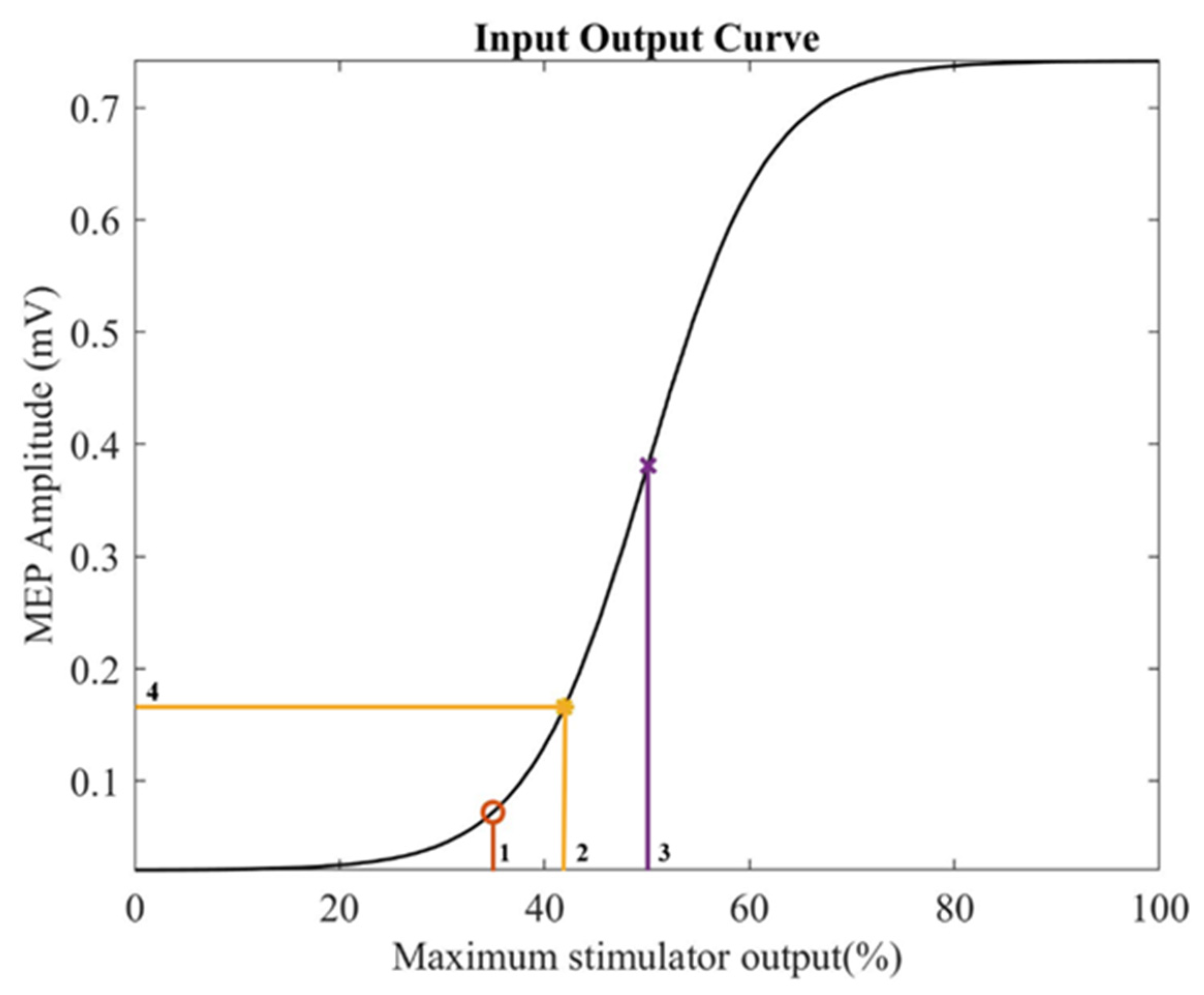
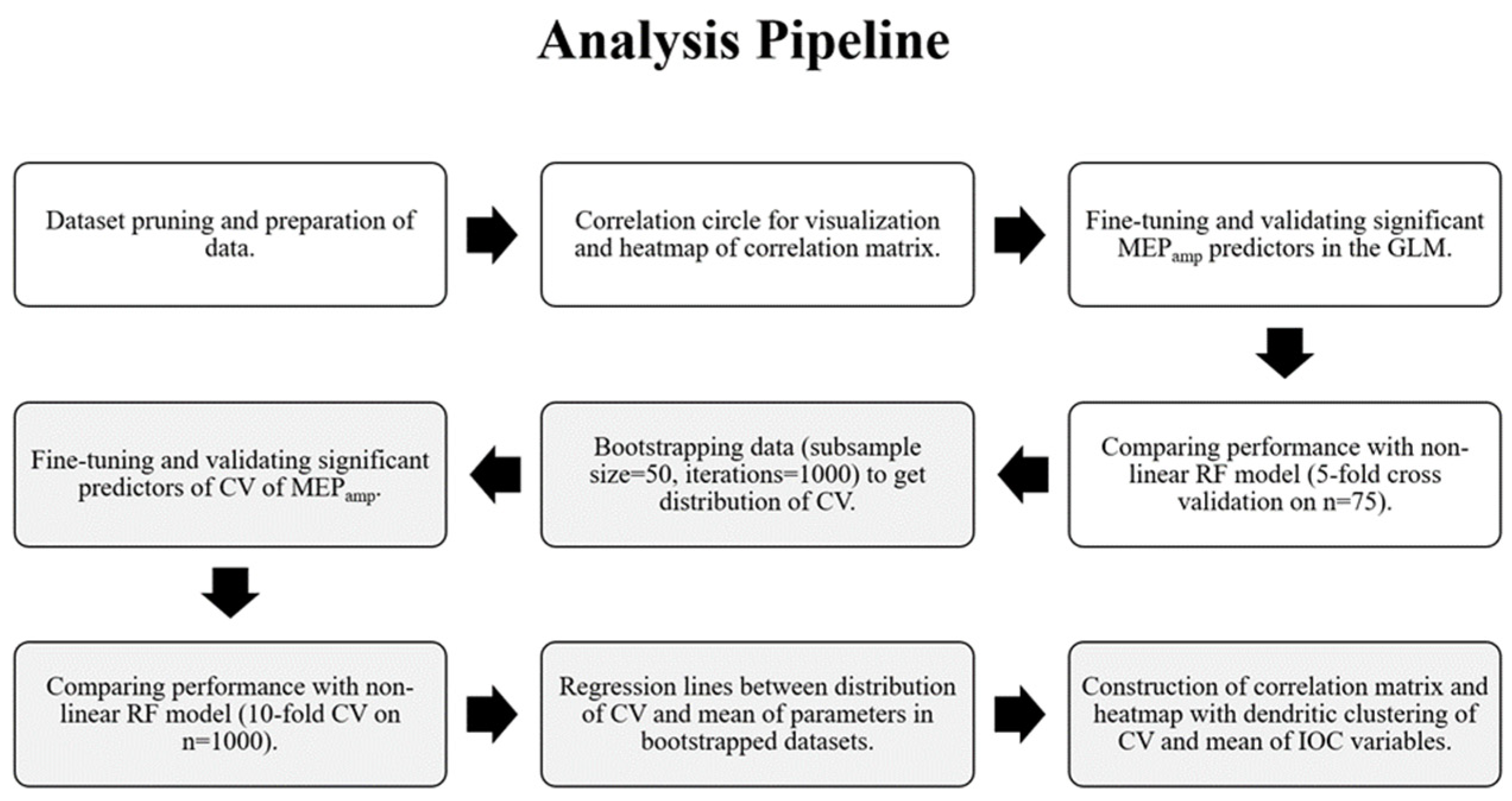

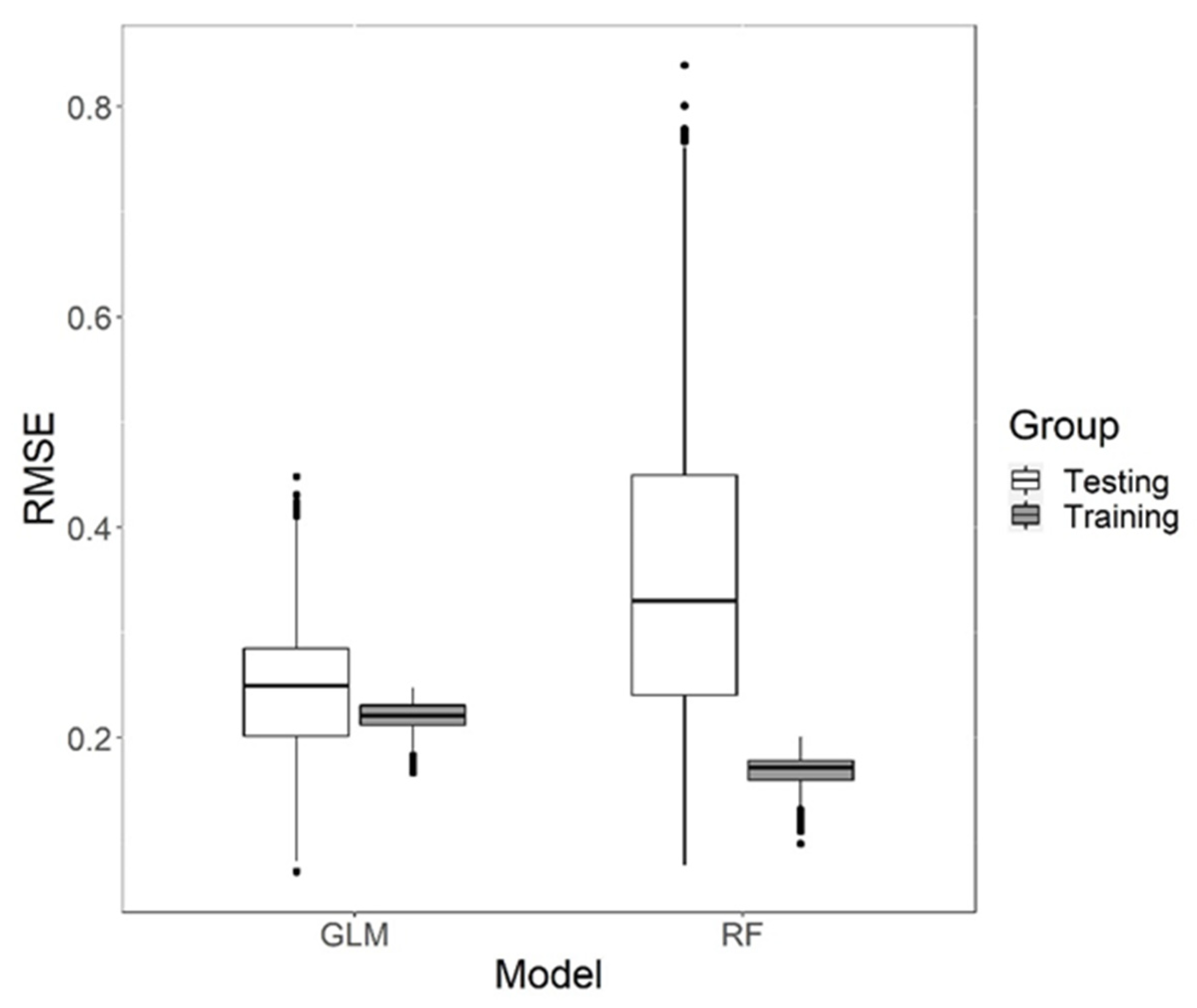
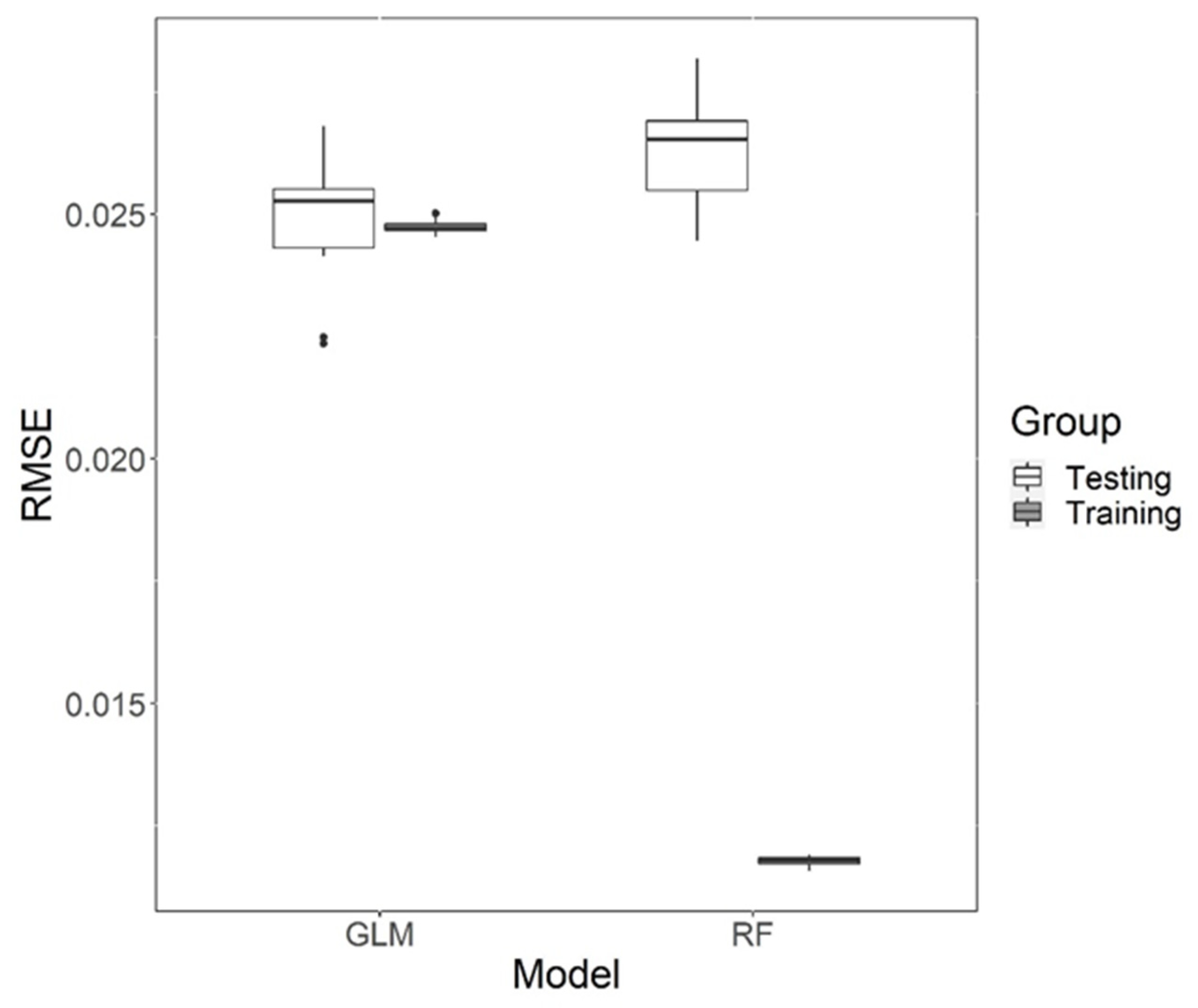
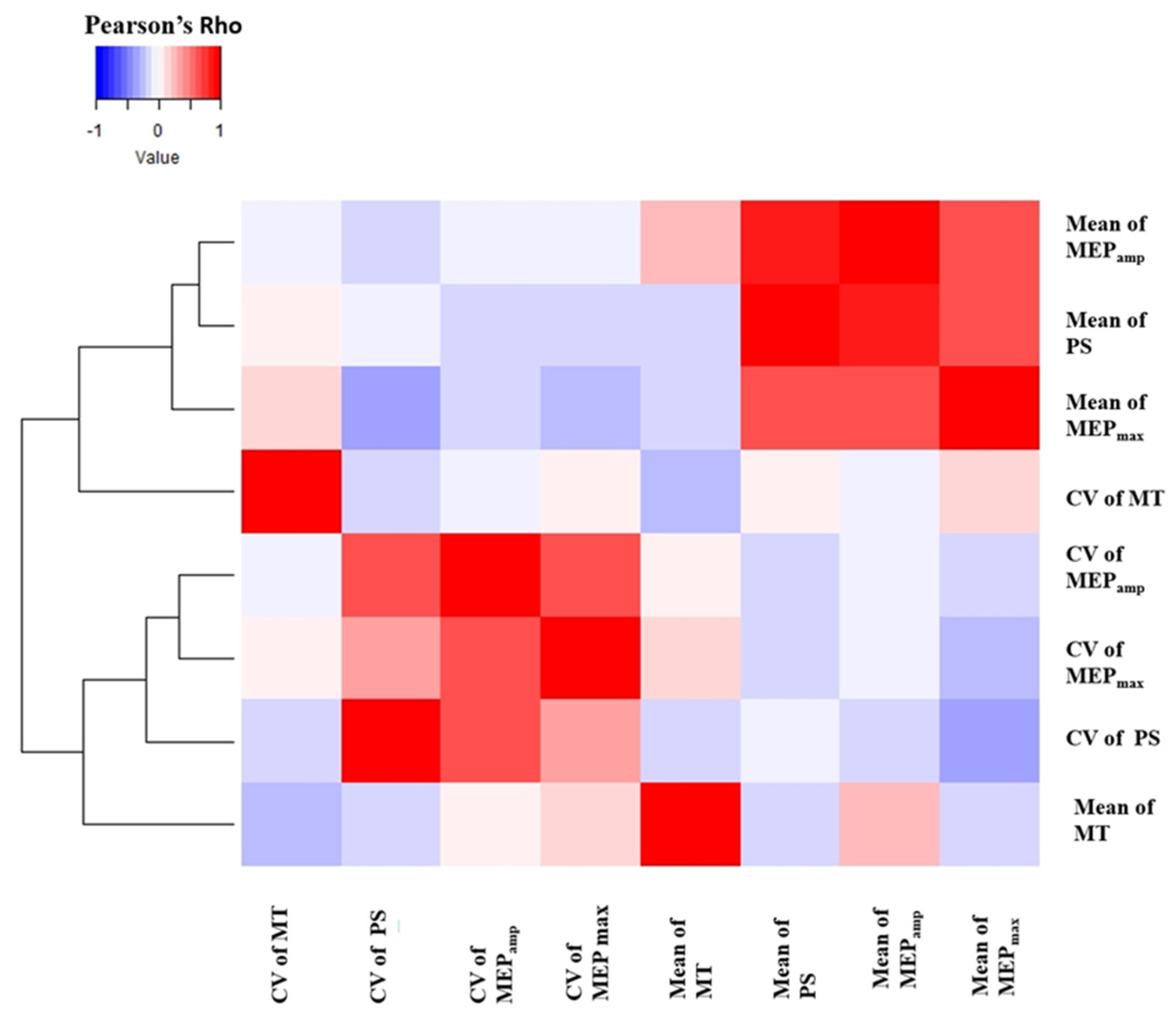
| Coefficient (β) | Standard Error (SE) | t-Stat | p-Value | VIF | |
|---|---|---|---|---|---|
| Intercept | 1.3733 | 0.0266 | 51.697 | <0.0001 | |
| MT | 0.3210 | 0.0271 | 11.856 | <0.0001 | 1.0252 |
| PS | 0.7650 | 0.0365 | 20.928 | <0.0001 | 1.8684 |
| MEPmax | 0.2270 | 0.0368 | 6.166 | <0.0001 | 1.8958 |
| Coefficient (β) | Standard Error (SE) | t-Stat | p-Value | VIF | |
|---|---|---|---|---|---|
| Intercept | −0.0235 | 0.0175 | −1.348 | 0.178 | |
| CV of PS | 0.4781 | 0.0187 | 25.581 | <0.0001 | 1.1138 |
| CV of MEPmax | 0.7482 | 0.0315 | 23.780 | <0.0001 | 1.1138 |
Publisher’s Note: MDPI stays neutral with regard to jurisdictional claims in published maps and institutional affiliations. |
© 2022 by the authors. Licensee MDPI, Basel, Switzerland. This article is an open access article distributed under the terms and conditions of the Creative Commons Attribution (CC BY) license (https://creativecommons.org/licenses/by/4.0/).
Share and Cite
Sarkar, A.; Dipani, A.; Leodori, G.; Popa, T.; Kassavetis, P.; Hallett, M.; Thirugnanasambandam, N. Inter-Individual Variability in Motor Output Is Driven by Recruitment Gain in the Corticospinal Tract Rather Than Motor Threshold. Brain Sci. 2022, 12, 1401. https://doi.org/10.3390/brainsci12101401
Sarkar A, Dipani A, Leodori G, Popa T, Kassavetis P, Hallett M, Thirugnanasambandam N. Inter-Individual Variability in Motor Output Is Driven by Recruitment Gain in the Corticospinal Tract Rather Than Motor Threshold. Brain Sciences. 2022; 12(10):1401. https://doi.org/10.3390/brainsci12101401
Chicago/Turabian StyleSarkar, Arkaprovo, Alish Dipani, Giorgio Leodori, Traian Popa, Panagiotis Kassavetis, Mark Hallett, and Nivethida Thirugnanasambandam. 2022. "Inter-Individual Variability in Motor Output Is Driven by Recruitment Gain in the Corticospinal Tract Rather Than Motor Threshold" Brain Sciences 12, no. 10: 1401. https://doi.org/10.3390/brainsci12101401
APA StyleSarkar, A., Dipani, A., Leodori, G., Popa, T., Kassavetis, P., Hallett, M., & Thirugnanasambandam, N. (2022). Inter-Individual Variability in Motor Output Is Driven by Recruitment Gain in the Corticospinal Tract Rather Than Motor Threshold. Brain Sciences, 12(10), 1401. https://doi.org/10.3390/brainsci12101401






